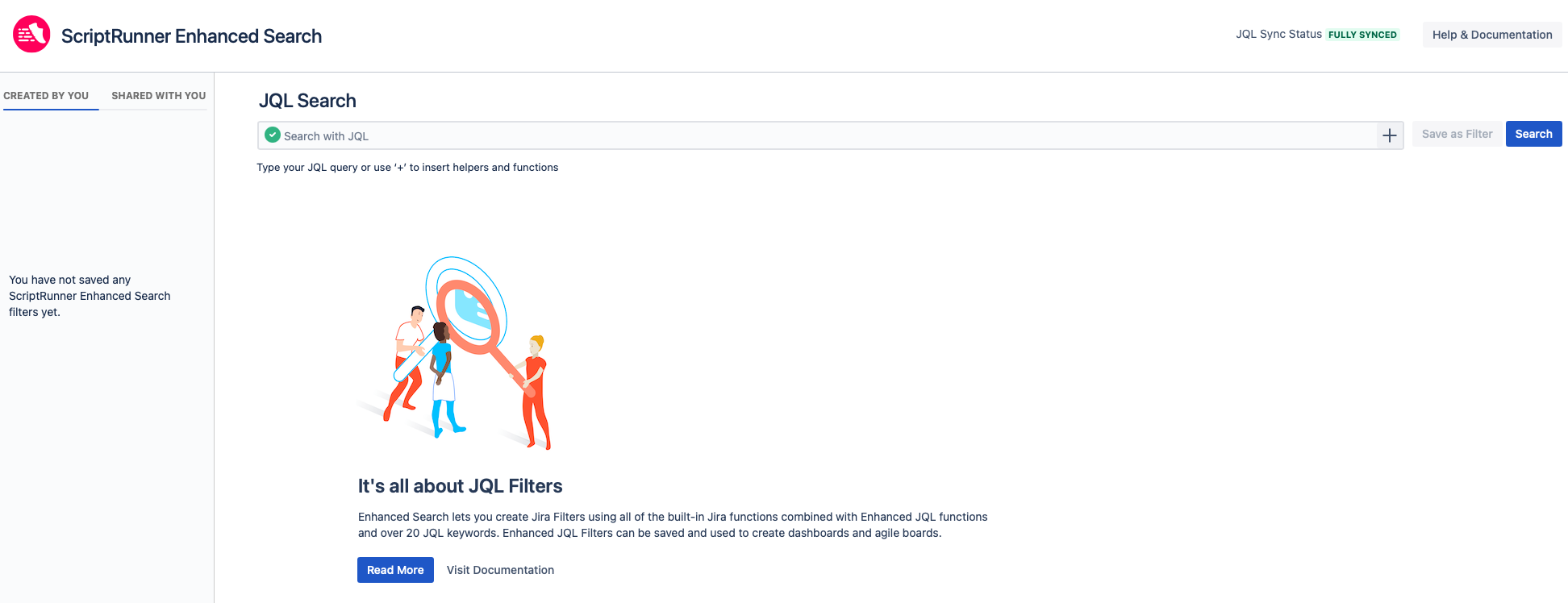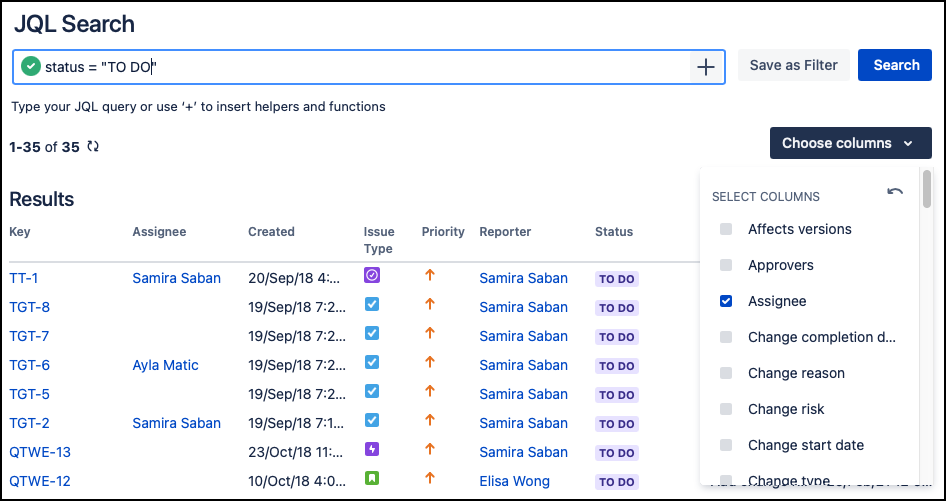ScriptRunner Enhanced Search JQL Queries
Run a Search
You can perform searches based on applied filters to view JQL queries which can be run as one-off searches or saved and shared. After installation and syncing:
- Select Apps→ScriptRunner Enhanced Search from the Jira menu bar located at the top of your page.
Alternatively, you can select Enhanced Search from the left navigation when viewing a project.
You will see the ScriptRunner Enhanced Search screen appear: - Enter your JQL query into the JQL Search bar and click the Search button.
If you are unfamiliar with writing JQL queries, click the Insert Function button '+' to open the Insert Functions and Users screen, shown below. This enables you to choose from pre-generated ScriptRunner Enhanced Search JQL queries provided in the Functions tab. - Select the function from the Available Functions list within the Functions tab. Depending on the function chosen, you may be required to enter or select subquery details to generate valid JQL for that function. For example, a subquery
"project = EXAMPLE"tells thelinkedIssuesOffunction that it should find issues linked to the results of that subquery. - Click the Add to query button.
- (Optional) You can also view the account IDs of users in your Jira instance within the Insert Functions and Users screen. To do so, select the user from the Users tab, view their account ID and click the Add to query button.
Click Search. You are returned to the JQL Search page with a list of results displayed for the function.
Search run-time
Searches can run for up to two minutes, with a progress bar indicating the status. We recommend simplifying your query as much as possible and using our Tips for Writing JQL Queries to reduce the run time.
- Check your query has returned the desired results before continuing and rerun if necessary.
Space required after comma
If you see an error message informing you that "Function 'X' does not exist", check that you have entered a space after the comma in the query you are running.
Customize Search Results
After running your enhanced JQL query, a table of results is displayed, showing customisable information about the issues returned. ScriptRunner Enhanced Search allows you to choose what information is displayed in the Results table, helping you to find what you need efficiently.
To customize the Results table view, click Choose Columns, and check the columns you wish to display.
Save a Search Filter
As well as running one-off searches, you can save your ScriptRunner Enhanced Search JQL queries as filters. Saving your query searches as filters allows you to use ScriptRunner Enhanced Search JQL functions in other JQL fields.
Follow the steps below to save your filter, and refer to Saved Filters to understand how these can be used.
- Run a search as outlined above and customize the results.
- Click the Save as filter button to save the filter and reuse it later. This opens the Save Filter window.
Name the filter and enable the Sync Filter toggle to ensure your filter stays in sync with Jira data changes and reflects updates across other areas. For example, you can use it in dashboards, Jira issue navigator, and Jira software boards.
Once created, new filters are not synchronized by default. All new filters are synchronized after the default interval of 5 minutes when the Sync Filter option is selected in the Filter Creation Screen. If the Sync Filter option is disabled, the filter does not automatically sync and must be manually synced from the Search screen using the Sync Filter button.
Every 'X' minute, ScriptRunner Enhanced Search will check if the search results of the filter have changed or if someone has changed the add-on settings recently. If that check is positive, then filters are synced with the changes made to the issues in your Jira instance.
Filters are always run with the same permissions set as the user who created the filter.
You must make sure that the Add-On User has the Global Permission to Browse Users for this feature to work.
If you want to update or delete these Enhanced Search filters, use the Enhanced Search page instead of the Jira filters user interface.
Choose who to share the filter with. There are three options: share with all, share with a select user group, or share with a project.
Checking Share With All shares the filter with all users logged into the Jira Cloud instance.
Entering one or more groups under Choose Groups, shares the filter with all members of the selected group(s).
Selecting one or more projects under Choose Projects, makes the saved filter available within the selected project(s).
Click Save.
To see all saved filters, click Jira Software and navigate to Issues and Filters→View All Filters.
Export a saved filter to a CSV file
Once you have performed a search and saved that search as a filter, you can export that saved filter as a .csv file. To do so:
- Navigate to Filters→View all filters.
- Choose the filter you want to export and select Export.
- Select the export type.
Use Search Results in a Jira Filter
If you need to use the results of your Enhanced Search filter inside a standard Jira filter such as a dashboard, Scrum, or Kanban board, then you can do this as follows:
- Create the filter on the enhanced search page.
- Save the filter and share it (This creates a copy of the filter as a standard Jira filter where we synchronise the list of issue keys returned by the enhanced search filter.)
Use the JQL below to access the results of this filter in the feature where you need to reference it.
filter=‘NameOfHisSharedESFilter’









